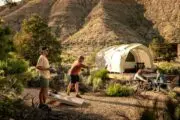In the late 1960s, San Francisco’s Haight-Ashbury district was best known for being an epicenter for counterculture hippies, free love and political protests. But what was the neighborhood like before Jefferson Airplane and Janis Joplin moved in?
Scroll through the photos below to see the history of this storied area of San Francisco. Once the site of farms and homesteads, it survived the Great Depression, flourished in the 60s and then went through another economic downturn before becoming the tourist destination it is today.
Cable railway cars near Golden Gate Park, 1900
Photo: OpenSFHistory/wnp13.234.jpg
Before the Market Street Cable Railway was built in 1883, Haight-Ashbury was mostly sand dunes and farms. After the railway made it more accessible, it became an upper-middle-class area.
The Haight Street line of the Market Street Cable Railway was powered by the Market and Valencia Powerhouse, with cars operating from a car barn near Golden Gate Park.
Chutes at the Beach, 1901
Photo: OpenSFHistory/wnp27.1305.jpg
Chutes at the Beach was an amusement park built in 1895 and moved to San Francisco’s Richmond district in 1902. The main attraction was a 60-foot structure that shot a gondola down into an artificial lake. Unheard of at the time, it reached a speed of 60 miles per hour.
Breadline in front of the Terminal Hotel, 1906
Photo: OpenSFHistory/wnp27.0594.jpg
Haight-Ashbury was one of the few neighborhoods spared from the rampant fires and utter destruction of San Francisco’s 1906 earthquake. However, the earthquake also caused a food shortage in the city, and those living in the area unfortunately did have to deal with that.
Refugees lining up for supplies outside the Young Men’s Hebrew Association, 1906
Photo: OpenSFHistory/wnp27.1157.jpg
Less fortunate families stayed as refugees in Golden Gate Park after the earthquake hit. Haight-Ashbury became an extremely desirable place to live due to the low amount of damage it suffered during the earthquake.
Buena Vista Park, 1910
Photo: OpenSFHistory/wnp14.0673.jpg
Buena Vista Park is San Francisco’s oldest official park. It’s located on a steep hill, and interestingly the paths along its west side are lined with gutters made of broken headstones from Victorian cemeteries in the city’s Laurel Heights area.
Kezar Pavilion construction, 1924
Photo: OpenSFHistory/wnp14.0116.jpg
Built in 1924, the Kezar Pavilion is an outdoor venue with space for 4,000 people. In the 1960s and 1970s, the Bay Bombers, a roller derby team, frequently played at the pavilion.
Streetcar and fire engine collision at Page Street and Clayton Street, 1944
Photo: OpenSFHistory/wnp14.3755.jpg
Even in the 1940s, when vehicles were much slower and Ubers and Lyfts didn’t exist, congested streets and traffic jams were inevitable.
7-Haight streetcar, 1946
Photo: OpenSFHistory/wnp32.0057.jpg
The 7-Haight streetcar existed from 1882 until 1948, only two years after the photo above was taken. Its turnaround spot was located in front of where Amoeba Records now sits.
Hippies in front of Stewart’s Style-O-Rama Barber Shop, 1967
Photo: OpenSFHistory/wnp28.1265.jpgg
Haight-Ashbury — or “Hashbury,” as Hunter S. Thompson liked to call it — offered the first ever head shop for those looking to easily purchase marijuana or LSD.
Crowd of young people at Haight Street and Cole Street, 1969
Photo: OpenSFHistory/wnp25.1915.jpg
After “The Summer of Love” in 1967, Haight-Ashbury fell into a period of economic downturn due to excessive drug use and lack of police presence. Even so, that year locals like Janis Joplin, Jefferson Airplane and The Doors could still be found playing at venues in the area.
Haight Street and Ashbury Street, 1969
Photo: OpenSFHistory/wnp25.1914.jpg
Haight-Ashbury began to recover from its economic downturn in the late 1970s.
Looking North from Twin Peaks, 1978
Photo: OpenSFHistory/wnp25.0935.jpg
That said, the late 1970s didn’t come without trouble. In 1978, Harvey Milk, who was the first openly gay politician to be elected to the San Francisco Board of Supervisors, was shot and killed by Dan White, a former police officer. Milk lived in the Castro district, not far from Haight-Ashbury and the Twin Peaks area.
Today, Haight-Ashbury is thriving once again, and has become a popular destination for tourists looking to relive the 60s.


















